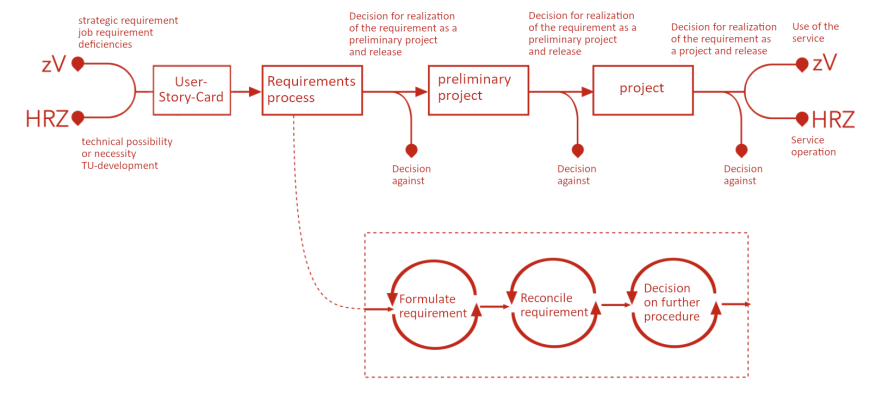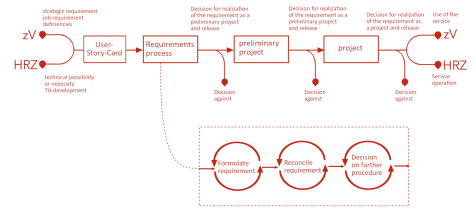A particular focus is put on the transparency of a requirement process. This means that all parties involved receive all necessary information within each phase of the development or change process and can agree on joint objectives.
By using requirement management, IT based solutions for administrative processes can be developed efficiently across multiple departments and directorates. This way, the risk of ill-matching solution components, missing features or inadequate solutions can be minimised.
IT requirements
IT requirements are requests for change that either effect existing IT solutions or lead to new IT solutions. IT requirements can appear in many ways: Ideas and requests, necessary modifications, correction of faults, strategic focus etc. To learn whether the present matter or issue is actually a requirement (that consequently cannot be solved using the HRZ ticketing system), it may be helpful to look into the classification of requirements.
Possible new IT requirements are submitted to the Staff Unit for IT & Process Management via a requirement request sheet. IT & Process Management coordinates the agreement process within the administration and with the HRZ through their IT coordination. Preliminary projects resulting in actual projects can only evolve after the necessary requirements have been jointly evaluated and agreed to.
Links & Downloads
Access restricted section: Log in to see this section.
The requirements process
Several sub-processes must be completed for services to evolve from idea to implementation. In addition to the requirement process, there are also the preliminary project (optional), the project and the review sub-processes. The entire process is an end-to-end process, which is supported on a higher level by the University Administration and the HRZ.
The requirements process is a sub-process that a requirement is run through until it reaches project maturity. During this process, requirements are identified, discussed, agreed upon and combined. The requesting party keeps track of the process and is walked through the process step-by-step by IT & Process Management.
In the first step, you may send your idea for an improvement or change proposal to IT & Process Management using the User-Story-Card so that your requirement can be structured, coordinated and processed further.
In the transition to the requirement request sheet, IT & Process Management assists and advises the requester in formulating the IT requirement.
Once the requirement has been identified and formulated, it can be processed and agreed upon in a next step by various administrative bodies. This includes in particular the IT working group of the University Administration (zV) and the IT Coordination Board. The IT working group of zV analyses possible dependencies and synergies ahead of time and specifies early requirement prioritisation. Within the requirements process, the IT Coordination Board makes the necessary decisions as a joint zV and HRZ administrative body regarding the prioritisation or internal and external implementation respectively. For strategic or larger endeavours as well as process escalations, higher authority levels, the Circle of Department Heads, the Vice President for Administration and Financial Affairs and the IT Coordination Board are also included.
If agreed upon mutually, the IT requirement can then be implemented as a project (or initially as a preliminary project) as it progresses. This completes the requirements process. The role of the requesting party as client, however, continues as the next process within the project management begins.
Please note also the instructions and guidelines for requirement management (opens in new tab). There you will find more information about requirement management focussing on the role of the requesting party in the requirements process. We will be happy to assist you, should you have more questions. The contact persons are listed here.






